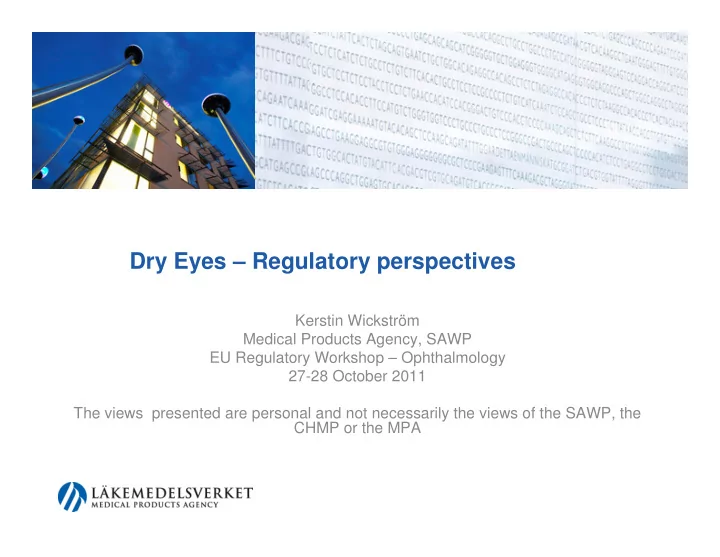

Dry Eyes – Regulatory perspectives Kerstin Wickström Medical Products Agency, SAWP EU Regulatory Workshop – Ophthalmology 27-28 October 2011 The views presented are personal and not necessarily the views of the SAWP, the CHMP or the MPA
Give a regulatory view on frequently asked questions • For example, – Study population – Endpoints – Comparator – Duration of studies – Adverse environment chamber – ...
No centrally approved pharmacological therapy in EU • Approved (MRP) Artificial tears – Pilocarpine 5 mg tablets • Symptomatic treatment of dry eyes in Sjögren’s syndrome • Used (SE) – Bromhexine 8 mg – Evening primrose ( Oenothera glazioviana ) – … Inserts & ointments *Certain medicinal products for external use (specific for SE)
Heterogeneous disease • Reason for dry eye? – Impaired tear function, meibomian gland dysfunction (MGD), mucin deficiency, extrinsic factors, a mix Evaporative Tear deficient
Define target population! • Reasons for dry eye • Well-documented history of DED – Persistence of symptoms • Severity – Reasonable to target a more severe population for pharmacological therapy • (Mild), moderate, severe? • Based on signs and symptoms • Duration of disease – Affect corneal sensitivity (symptoms)? – Affect severity?
Endpoints - Requirements • Which weight are they given? • What are the associated claims? • All data will be considered • Benefits in relation to risks 6
Endpoints • Signs and symptoms – Normally significant differences both in symptoms and signs required (co-primary endpoint) – Significant effect in sign or symptoms with a strong trend in the other • Multiplicity
Signs (I) • Consider target population – Selection of one sign over the other guided by • disease aetiology • underlying mechanism of action of the compound • phase II data • Frequently used – Corneal staining (Oxford, NEI) • Justify validity of other scales – Schirmer – Tear break up time • generally a secondary endpoint, of importance in MGD
Signs (II) • Upcoming – Tear osmolarity • Option if supported with validated evidence – Ocular protection index? • Limited info • In MGD – Appearance of lid margin abnormalities/redness and/or gland obstruction/drop out • Standardised grading and evaluation system not available – Composition of meibum?
Symptoms • Symptomatic disease! • Composite measure recommended – Validated questionnaire – MGD - no specific questionnaire available • Use of one single worst symptom discouraged – Subjectivity and variability limit usefulness • Adequate marker of a subjective clinical benefit?? – Changes in other symptoms may not parallel worst symptom over time – Multiplicity!
In addition • Address the intended mode of action of the compound – Tear production – Marker of mucin secretion – Meibum composition – Marker of ocular surface inflammation
Effect size • Statistical significance not all… – Relevant effect size! – The effects size needs to be supported for the chosen endpoint • Include evaluation of mean changes and responder analyses – Difference between the means must be clinically relevant – Predefined relevant definition of responders
Comparator (I) • Vehicle – Straight forward – Addresses potential effect/intolerance of vehicle • Artificial tears – If target population already regular users (more severe population) – If composition of vehicle similar to what is included in artificial tears
Comparator (II) • In MGD – Vs. best standard of care? • Best standard of care not defined – lid hygiene/warm compresses/lid massage – artificial tears/topical lipid supplements – (topical antibiotics/tetracycline p.o.) – Masking and compliance with lid hygiene an issue!
Concomitant use of artificial tears • May be necessary to prevent a large drop-out (in vehicle group) – if infrequent administration • Must be documented • Address extent of use as a secondary outcome
Duration of studies • Pharmacological treatment – Efficacy • When chronic treatment foreseen, primary evaluation at 6 months to confirm that effect is maintained – Safety • Generally 12 months (ICH E1 Population Exposure) – If (chronic) intermittent use foreseen, consider randomised withdrawal to evaluate maintenance. • Artificial tears – If new composition, 3 months generally sufficient for efficacy. – Longer safety follow up needed.
Controlled adverse environment • Useful in exploratory trials – Proof of concept – Aid in dose selection – Evaluate biomarkers • Not acceptable as pivotal trial without environmental study – selects an enriched patient population • questioned whether this population is representative for target population – lose real life heterogeneity • overestimation of effect
Inflammation • Several anti-inflammatory products in development • 2ndary manifestation • Need to address in PD studies (biomarkers) • Exploratory marker in pivotal studies • Duration of effect after discontinuation of treatment?
Studies in general • Superiority trials – Lack of comparator in EU – If available, assay sensitivity still an issue • History of failures, two confirmatory studies recommended – Don’t have to be replicates – One pivotal trial • A clinically convincing and statistically compelling outcome needed (PtC One Pivotal study CPMP/EWP/2330/99)
In conclusion • Sign & symptoms stage • Need to learn more about the disease(s) • Need to get a better understanding of – the relevance and usefulness of different outcome measures – the strengths and weaknesses of the symptom scales and visual function quality of life questionnaires
Questions? 21
Recommend
More recommend